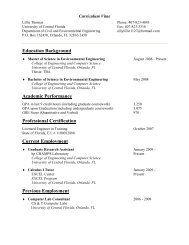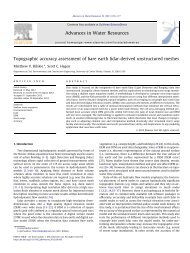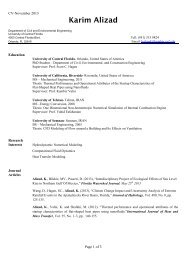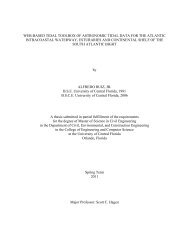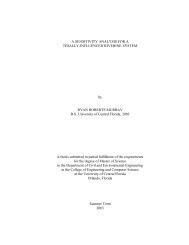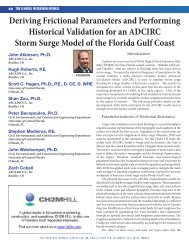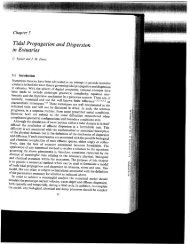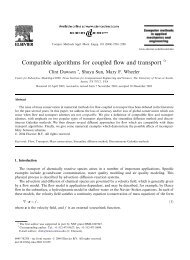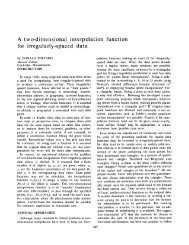Classical tidal harmonic analysis including error estimates in ...
Classical tidal harmonic analysis including error estimates in ...
Classical tidal harmonic analysis including error estimates in ...
You also want an ePaper? Increase the reach of your titles
YUMPU automatically turns print PDFs into web optimized ePapers that Google loves.
Computers & Geosciences 28 (2002) 929–937<br />
<strong>Classical</strong> <strong>tidal</strong> <strong>harmonic</strong> <strong>analysis</strong> <strong><strong>in</strong>clud<strong>in</strong>g</strong> <strong>error</strong> <strong>estimates</strong> <strong>in</strong><br />
MATLAB us<strong>in</strong>g T TIDE $<br />
Rich Pawlowicz a, *, Bob Beardsley b , Steve Lentz b<br />
a Department of Earth and Ocean Sciences, University of British Columbia, 6270 University Blvd., Vancouver, BC, Canada V6T 1Z4<br />
b Woods Hole Oceanographic Institution, Woods Hole, MA 02543 USA<br />
Abstract<br />
Received 24 September 2001; received <strong>in</strong> revised form 13 February 2002; accepted 28 February 2002<br />
A standard part of any oceanic pressure gauge or current meter <strong>analysis</strong> is the separation of <strong>tidal</strong> from non-<strong>tidal</strong><br />
components of the signal. The <strong>tidal</strong> signal can either be discarded, or its characteristics described <strong>in</strong> some fashion useful<br />
for further <strong>analysis</strong>. Although <strong>tidal</strong> signals can be removed by standard high or bandpass filter<strong>in</strong>g techniques, their<br />
relatively determ<strong>in</strong>istic character and large amplitude make special techniques more effective. In classical <strong>harmonic</strong><br />
<strong>analysis</strong>, the <strong>tidal</strong> signal is modelled as the sum of a f<strong>in</strong>ite set of s<strong>in</strong>usoids at specific frequencies related to astronomical<br />
parameters. A set of programs has been written <strong>in</strong> MATLAB to (a) perform classical <strong>harmonic</strong> <strong>analysis</strong> for periods of<br />
about 1 year or shorter, (b) account for (some) unresolved constituents us<strong>in</strong>g nodal corrections, and (c) compute<br />
confidence <strong>in</strong>tervals for the analyzed components. r 2002 Elsevier Science Ltd. All rights reserved.<br />
Keywords: Tides; Confidence <strong>in</strong>terval; Oceanography<br />
1. Introduction<br />
As the earth rotates on its axis, spatially vary<strong>in</strong>g<br />
gravitational forces from the moon and the sun act on<br />
the ocean, generat<strong>in</strong>g a forced elevation and current<br />
response primarily (but not solely) at diurnal and semidiurnal<br />
frequencies. Body forces act directly on deep<br />
oceanic waters. Tidal effects <strong>in</strong> coastal regions are not<br />
directly forced by these astronomical forces. Instead<br />
they arise as a side-effect of deep oceanic variability,<br />
propagat<strong>in</strong>g through shallower coastal waters as a wave<br />
or a comb<strong>in</strong>ation of waves. In a typical oceanic time<br />
series, <strong>tidal</strong> variability is often the largest signal. Power<br />
spectra for such time series are often characterized by<br />
a broad hump with a low-frequency maximum and a<br />
decl<strong>in</strong>e at higher frequencies. Superimposed are a<br />
$ Code available from server at http://www.iamg.org/CG-<br />
Editor/<strong>in</strong>dex.htm or http://www.ocgy.ubc.ca/~rich.<br />
*Correspond<strong>in</strong>g author. Tel.: +1-604-822-1356; fax: +1-<br />
604-822-6091.<br />
E-mail address: rich@ocgy.ubc.ca (R. Pawlowicz).<br />
0098-3004/02/$ - see front matter r 2002 Elsevier Science Ltd. All rights reserved.<br />
PII: S 0098-3004(02)00013-4<br />
number of sharp <strong>tidal</strong> peaks near diurnal and semidiurnal<br />
frequencies, and sometimes a broader peak<br />
associated with Coriolis or <strong>in</strong>ertial effects. Dynamical<br />
<strong>analysis</strong> requires the separation of the <strong>tidal</strong> signal from<br />
sub or super-<strong>tidal</strong> variations, or <strong>in</strong> some cases separation<br />
of <strong>tidal</strong> effects from <strong>in</strong>ertial effects at a nearby<br />
frequency. The <strong>tidal</strong> <strong>in</strong>formation is either discarded or<br />
kept for further <strong>analysis</strong>.<br />
Standard high/low/bandpass filter<strong>in</strong>g techniques (e.g.,<br />
Jackson 1986) can be used but <strong>in</strong> general these are<br />
<strong>in</strong>efficient because fairly narrow filters with a great deal<br />
of rejection are needed. Also, although these are useful<br />
<strong>in</strong> analyz<strong>in</strong>g non-<strong>tidal</strong> variability, they provide no<br />
compression of the <strong>tidal</strong> <strong>in</strong>formation. Specialized<br />
techniques have been devised to take advantage of the<br />
‘‘determ<strong>in</strong>istic’’ nature of <strong>tidal</strong> processes. In classical<br />
<strong>harmonic</strong> <strong>analysis</strong>, the <strong>tidal</strong> forc<strong>in</strong>g is modelled as a set<br />
of spectral l<strong>in</strong>es, i.e., the sum of a f<strong>in</strong>ite set of s<strong>in</strong>usoids<br />
at specific frequencies. These frequencies are specified by<br />
various comb<strong>in</strong>ations of sums and differences of <strong>in</strong>teger<br />
multiples of 6 fundamental frequencies aris<strong>in</strong>g from<br />
planetary motions (God<strong>in</strong>, 1972). These fundamental
930<br />
parameters represent effects of rotation of the earth<br />
(lunar day of 24:8 h), the orbit of the moon around the<br />
earth (lunar month of 27 days) and the earth around the<br />
sun (tropical year), and periodicities <strong>in</strong> the location of<br />
lunar perigee (8.85 years), lunar orbital tilt (18.6 years),<br />
and the location of perihelion (E21 000 years). The set<br />
of 6 signed <strong>in</strong>tegers required to describe a particular<br />
frequency are called the Doodson numbers. Many of the<br />
more important frequencies have names such as ‘‘M2’’,<br />
‘‘K1’’, etc. From astronomical considerations alone, an<br />
‘‘equilibrium’’ response can be predicted; this is the<br />
phase and amplitude that would be observed if<br />
the response of the earth was fast enough that the<br />
surface deformation was effectively <strong>in</strong> equilibrium with<br />
the forc<strong>in</strong>g at all times. The real ocean is def<strong>in</strong>itely not <strong>in</strong><br />
equilibrium with the <strong>tidal</strong> forc<strong>in</strong>g. However, as <strong>tidal</strong><br />
amplitudes are small compared with the total ocean<br />
depth, the dynamics are very nearly l<strong>in</strong>ear, imply<strong>in</strong>g that<br />
the forced response conta<strong>in</strong>s only those frequencies<br />
present <strong>in</strong> the forc<strong>in</strong>g. A least-squares fit can be used to<br />
determ<strong>in</strong>e the relative phase and amplitude of each<br />
frequency <strong>in</strong> the response. This phase/amplitude data<br />
thus provides a compression of the data <strong>in</strong> the complete<br />
time series, which can then be compared with similar<br />
data at other locations to understand the characteristics<br />
of <strong>tidal</strong> dynamics, or can be used to synthesize time<br />
series of <strong>tidal</strong> effects at other times for predictive<br />
purposes.<br />
There are several drawbacks to classical <strong>harmonic</strong><br />
<strong>analysis</strong>. The first is that, ignor<strong>in</strong>g the modulation of<br />
perihelion which is effectively constant over historical<br />
time, an E18:6 year time series is required to resolve all<br />
of the listed frequencies (that is, the number of<br />
wavelengths of each constituent <strong>in</strong> the record is at least<br />
1 different from all other constituents). In practice,<br />
record lengths are often 1 year or shorter. In order to<br />
handle this issue an assumption is made that the phase/<br />
amplitudes of response s<strong>in</strong>usoids with similar frequencies<br />
(i.e., those whose first three Doodson numbers are<br />
identical) are <strong>in</strong> the same proportion as those of the<br />
equilibrium response under the reasonable premise that<br />
the ocean response should be similar at similar<br />
frequencies. In such a cluster large equilibrium peaks<br />
are surrounded by small subsidiary peaks <strong>in</strong> frequencyspace<br />
which provide ‘‘nodal modulations’’ (or more<br />
correctly, ‘‘satellite modulations’’) to the ma<strong>in</strong> peak.<br />
The appearance of the total signal will be a s<strong>in</strong>usoid<br />
whose phase and amplitude varies slowly with time.<br />
These changes are slow enough to be considered<br />
effectively constant for record lengths of up to 1 year.<br />
At much shorter record lengths another problem arises.<br />
The frequency resolution further degrades until even<br />
dissimilar constituents are unresolvable. The best solution<br />
is to apply <strong>in</strong>ference. This technique for f<strong>in</strong>d<strong>in</strong>g the<br />
absolute phase/amplitude requires that the relative<br />
differences <strong>in</strong> phase/amplitude between the two unre-<br />
R. Pawlowicz et al. / Computers & Geosciences 28 (2002) 929–937<br />
solved constituents is known from other nearby data. If<br />
this is not the case, it is thought best to either discard the<br />
smaller constituents and fit only to the largest <strong>in</strong> a given<br />
frequency <strong>in</strong>terval, or to use the equilibrium response to<br />
establish the desired differences.<br />
Another drawback of classical <strong>analysis</strong> is that it<br />
provides no easy way to determ<strong>in</strong>e whether the result<strong>in</strong>g<br />
phase/amplitude of a given s<strong>in</strong>usoid is mean<strong>in</strong>gful <strong>in</strong> a<br />
determ<strong>in</strong>istic way (i.e., it is truly a <strong>tidal</strong> l<strong>in</strong>e), or whether<br />
it results from fitt<strong>in</strong>g to a component of the non-<strong>tidal</strong><br />
broad-spectrum variability. In general a fit is likely to<br />
<strong>in</strong>clude elements of both and some k<strong>in</strong>d of confidence<br />
<strong>in</strong>terval for the determ<strong>in</strong>istic part is useful. To address<br />
this issue, the ‘‘response’’ method was <strong>in</strong>vented (Munk<br />
and Cartwright, 1966). Although this provides better<br />
results than classical <strong>harmonic</strong> <strong>analysis</strong>, it has not found<br />
widespread use.<br />
Further problems with classical <strong>harmonic</strong> <strong>analysis</strong><br />
arise <strong>in</strong> coastal regions where the <strong>tidal</strong> response is <strong>in</strong> the<br />
form of a wave propagat<strong>in</strong>g onshore. In large estuaries,<br />
the seasonal change <strong>in</strong> sal<strong>in</strong>ity and flow may change the<br />
dynamic response but as these changes can vary from<br />
year to year the <strong>tidal</strong> process is not really stationary.<br />
Instead spectral peaks are broadened so that they are no<br />
longer pure l<strong>in</strong>es, but, depend<strong>in</strong>g on the situation, such<br />
variations may be treated as l<strong>in</strong>es <strong>in</strong> the <strong>analysis</strong>. With<strong>in</strong><br />
smaller estuaries, <strong>tidal</strong> height variations may be significant<br />
compared to water column depth and a variety<br />
of non-l<strong>in</strong>ear effects can occur. For example, flood<br />
periods shorten and <strong>in</strong>tensify and ebbs lengthen. As long<br />
as these effects are reasonably determ<strong>in</strong>istic they may be<br />
handled by add<strong>in</strong>g extra ‘‘shallow water’’ constituents<br />
which occur at sum/difference frequencies of the major<br />
constituents. More problematic <strong>in</strong> these regions are the<br />
effects of <strong>in</strong>ternal variability. Tidal <strong>in</strong>teractions with<br />
vary<strong>in</strong>g topography can produce large <strong>in</strong>ternal waves<br />
and bores whose characteristics are highly sensitive to<br />
ambient stratification. In such cases the assumption of<br />
‘‘l<strong>in</strong>e’’ frequencies becomes questionable and other<br />
techniques such as wavelet <strong>analysis</strong> have been suggested<br />
(Jay and Fl<strong>in</strong>chem, 1999). More comprehensive descriptions<br />
of <strong>analysis</strong> techniques, their use, and their<br />
limitations is given <strong>in</strong>, e.g., Foreman et al. (1995) and<br />
God<strong>in</strong> (1991).<br />
Here, we describe T TIDE, a package of rout<strong>in</strong>es that<br />
can be used to perform classical <strong>harmonic</strong> <strong>analysis</strong> with<br />
nodal corrections, <strong>in</strong>ference, and a variety of userspecified<br />
options. Predictions can also be made us<strong>in</strong>g the<br />
analyzed constituents. There are several novel features.<br />
First, although the <strong>harmonic</strong> <strong>analysis</strong> algorithm with<br />
nodal corrections, etc., itself is not orig<strong>in</strong>al (other than<br />
conversion to complex algebra), it is implemented <strong>in</strong><br />
MATLAB, an <strong>analysis</strong> package widely used by oceanographers.<br />
This allows for easy use with<strong>in</strong> the framework<br />
of a complete <strong>analysis</strong> <strong>in</strong>volv<strong>in</strong>g plott<strong>in</strong>g of raw data,<br />
scatter plots, and so forth. Second, the code is written
directly <strong>in</strong> matrix terms and thus relatively easy to<br />
understand and modify if required. F<strong>in</strong>ally, <strong>in</strong> order to<br />
differentiate between true determ<strong>in</strong>istic (l<strong>in</strong>e) frequencies<br />
and broad-spectrum variability, confidence <strong>in</strong>tervals for<br />
the estimated <strong>tidal</strong> parameters are computed us<strong>in</strong>g one<br />
of several user-selectable algorithms. The package is<br />
made up of a number of files each of which conta<strong>in</strong> one<br />
or more functions. User-callable functions generally<br />
have a ‘‘t ’’ prefix to prevent namespace collisions.<br />
The paper is composed of four parts. In the first the<br />
form of the equilibrium potential is described. In the<br />
second part the mathematical basis of the technique for<br />
mak<strong>in</strong>g phase/amplitude <strong>estimates</strong> is described. In the<br />
third part the generation of confidence <strong>in</strong>tervals is<br />
outl<strong>in</strong>ed. F<strong>in</strong>ally an illustrative example is discussed.<br />
2. Tidal potential<br />
The effect of gravitational force vectors from the sun<br />
and moon, F; can be written as the gradient of a scalar<br />
potential V; F ¼ rV: The magnitude of this potential<br />
at the earth’s surface at any time obviously is dependent<br />
on the relative positions of the earth, moon, and sun. In<br />
Doodson’s development (Doodson, 1954, described <strong>in</strong><br />
God<strong>in</strong>, 1972) the potential is written as a function of<br />
lunar time t (def<strong>in</strong>ed to beg<strong>in</strong> at ‘‘lunar midnight’’) and<br />
other astronomical variables (which are also functions<br />
of time):<br />
s is the mean longitude of moon, h the mean longitude<br />
of sun, p the longitude of perigee, N0 the negative of<br />
the longitude of the ascend<strong>in</strong>g node, and p0 is the<br />
longitude of perihelion, where all terms are <strong>in</strong> units of<br />
cycles. These variables can be evaluated for a given<br />
Julian date us<strong>in</strong>g the function t astron which implements<br />
formulas <strong>in</strong> Seidelmann (1992). Their effects are<br />
comb<strong>in</strong>ed with the Doodson number set for a particular<br />
constituent fi0 ; j0 ; k0 ; l0 ; m0 ; n0g <strong>in</strong>to the astronomical<br />
argument Va ¼ i0t þ j0s þ k0h þ l0p þ m0N 0 þ n0p0 : Sets<br />
with a common i0 are called a species (thus the slow,<br />
diurnal, and semidiurnal species for i0 ¼ 0; 1; and 2;<br />
respectively), and sets with common i0j0k 0 are called a<br />
subgroup. The constituent frequency s is def<strong>in</strong>ed as s ¼<br />
2p dVa=dt: The <strong>tidal</strong> potential is then written <strong>in</strong> the form<br />
"<br />
V ¼ X3<br />
i 0 ¼0<br />
þ G 0 i 0ðyÞ<br />
Gi 0ðyÞ<br />
X<br />
j 0 k 0 l 0 m 0 n 0<br />
X<br />
j 0 k 0 l 0 m 0 n 0<br />
A 0 i0j 0k0 l0m0 n0 cosð2pVaÞ<br />
B 0 i0j 0k0 l0m0 #<br />
n0 s<strong>in</strong>ð2pVaÞ : ð1Þ<br />
For a given Doodson number set either A 0 or B 0 is nonzero,<br />
but not both. These constants are tabulated and<br />
stored <strong>in</strong> data structures that can be loaded us<strong>in</strong>g<br />
t getconsts. The geodetic functions Gi0 and G0 i0 vary with<br />
species i0 and latitude y; and also depend on such<br />
R. Pawlowicz et al. / Computers & Geosciences 28 (2002) 929–937 931<br />
constants as the radius of the earth and the masses and<br />
separations of the earth, moon, and sun. The equilibrium<br />
amplitude for a constituent is def<strong>in</strong>ed as<br />
GA 0 =g or G 0 B 0 =g; where g is the gravitational acceleration,<br />
and can be generated for a particular latitude us<strong>in</strong>g<br />
t equilib.<br />
3. Phase/amplitude <strong>estimates</strong><br />
The algorithm used here for mak<strong>in</strong>g phase and<br />
amplitude <strong>estimates</strong> is based on algorithms and FOR-<br />
TRAN code described by God<strong>in</strong> (1972), Foreman<br />
(1977), and Foreman (1978). However, unlike those<br />
authors we use complex algebra directly rather than deal<br />
with s<strong>in</strong>e and cos<strong>in</strong>e fits separately. This has the<br />
advantage of unify<strong>in</strong>g the treatment for scalar (e.g.,<br />
pressure) and vector (e.g., horizontal currents) time<br />
series which are represented as complex numbers u þ iv:<br />
Note that the complex form for currents is based on a<br />
physical model of a rotat<strong>in</strong>g current vector, and is only<br />
valid for l<strong>in</strong>ear or nearly l<strong>in</strong>ear <strong>tidal</strong> waves. In some<br />
cases it may be better to treat, e.g., along and acrosschannel<br />
currents as two separate scalar time series.<br />
Consider a time series of observations yðtÞ; t ¼<br />
t1; t2; y; tM arranged <strong>in</strong> a vector, where the observation<br />
times are regularly spaced at an <strong>in</strong>terval Dt (default 1 h)<br />
and M is an odd number (an endpo<strong>in</strong>t is discarded if<br />
required). The time axis is def<strong>in</strong>ed such that the orig<strong>in</strong><br />
(or central time) is at tðMþ1Þ=2: Some miss<strong>in</strong>g observations<br />
can be handled by us<strong>in</strong>g a ‘‘miss<strong>in</strong>g data’’ marker<br />
<strong>in</strong> the <strong>in</strong>put vector (by MATLAB convention this is<br />
NaN, the IEEE arithmetic representation for Not-a-<br />
Number). This regular <strong>in</strong>terval restriction does not arise<br />
from the least-squares fit itself but rather from the<br />
automated constituent-selection algorithm and is also a<br />
requirement when spectra are estimated <strong>in</strong> one of<br />
the confidence <strong>in</strong>terval algorithms. This time series<br />
may be composed of either real or complex numbers.<br />
The time series is passed to the <strong>analysis</strong> program t tide<br />
along with a variety of (mostly optional) parameters.<br />
The <strong>tidal</strong> response is modelled as<br />
xðtÞ ¼b0 þ b1t þ X<br />
ake iskt<br />
þ a ke iskt<br />
; ð2Þ<br />
k¼1;y;N<br />
where N constituents (each with unique Doodson<br />
number sets) are used. Each constituent has a frequency<br />
sk which is known from the development of the<br />
potential, and a complex amplitude ak which is not<br />
known, although if yðtÞ is a real time series ak and a k<br />
are complex conjugates. A possible offset and (optional)<br />
l<strong>in</strong>ear drift is handled by the first two terms. The<br />
traditional approach uses real s<strong>in</strong>usoids:<br />
xðtÞ ¼b0 þ b1t þ X<br />
Ak cosðsktÞþBk s<strong>in</strong>ðsktÞ ð3Þ<br />
k¼1;y;N
932<br />
and is related to Eq. (2) by Ak ¼ ak þ a k and Bk ¼<br />
iðak a kÞ: The real representation is more convenient<br />
for the l<strong>in</strong>ear <strong>error</strong> <strong>analysis</strong> described later.<br />
Constituents can be chosen from a list of 45<br />
astronomical and 101 shallow-water constituents. Data<br />
structures conta<strong>in</strong><strong>in</strong>g names and other <strong>in</strong>formation<br />
about these constituents are loaded us<strong>in</strong>g t getconsts.<br />
There are several alternatives for select<strong>in</strong>g constituents.<br />
For general use, an automated selection algorithm<br />
(follow<strong>in</strong>g Foreman, 1977) is <strong>in</strong> place, which works as<br />
follows. A basis of all astronomical and 24 of the most<br />
important shallow-water constituents are gathered<br />
together. All constituents are listed <strong>in</strong> order of predef<strong>in</strong>ed<br />
importance based on equilibrium amplitudes.<br />
Less important constituents whose frequencies are less<br />
than a Rayleigh resolution limit aðNDtÞ 1 (with default<br />
a ¼ 1) apart from more important constituents <strong>in</strong><br />
frequency are discarded. Additional shallow-water constituents<br />
can be specified if required. If the relative<br />
phase/amplitude of two constituents that are otherwise<br />
unresolvable is known from other sources, then an<br />
<strong>in</strong>ference procedure can be carried out. Alternatively,<br />
constituent lists can be explicitly specified.<br />
The least-squares fit are the coefficients m<strong>in</strong>imiz<strong>in</strong>g<br />
E ¼ X<br />
jxðtmÞ yðtmÞj 2 ¼jjTa yjj 2 ; ð4Þ<br />
m<br />
where y ¼½yðt1Þ; yðt2Þ; y; yðtMÞŠ 0 ; a ¼½b0; b1; a1; a 1; a2;<br />
a 2; y; a NŠ 0 ; and T is an M 2N þ 2 matrix of l<strong>in</strong>ear<br />
and s<strong>in</strong>usoidal basis functions evaluated at observation<br />
times. The solution is found us<strong>in</strong>g the Matlab ‘‘W’’<br />
matrix division operator.<br />
Once the fit has been performed, various corrections<br />
are applied. These are generated <strong>in</strong> t vuf. First, the phase<br />
of the constituent response is usually reported as<br />
‘‘Greenwich phase’’ gk; that is, phase referenced to the<br />
phase of the equilibrium response at 01 longitude (the<br />
Greenwich meridian). This can be <strong>in</strong>terpreted as<br />
report<strong>in</strong>g the phase of the response at the time when<br />
the equilibrium forc<strong>in</strong>g is at its largest positive value at<br />
01 longitude. It is simplest to f<strong>in</strong>d the fitted phase at the<br />
central time of the record ðt ¼ 0Þ; the equilibrium phase<br />
vk is then just Va for the given constituent computed at<br />
the Julian date correspond<strong>in</strong>g to this central time, with<br />
possible adjustments of 1 1 3<br />
4 ; 2 ; or 4 cycle depend<strong>in</strong>g on<br />
whether A or B is non-zero, and their signs.<br />
Second, if a latitude is specified, then nodal or satellite<br />
corrections are computed as follows. Consider a ma<strong>in</strong><br />
peak of <strong>in</strong>dex k with satellites with <strong>in</strong>dices kj: The effect<br />
of the different satellites will be to slowly modulate the<br />
phase/amplitude of the ma<strong>in</strong> peak over various periods,<br />
usually more than 8 years. Our fitted response #ak over<br />
some period can then be written as a modification of the<br />
‘‘true’’ response of the ma<strong>in</strong> constituent ak; <strong>in</strong> which the<br />
amplitude is changed by a factor fk and the phase by an<br />
angle uk due to the presence of the satellites. fk and uk<br />
R. Pawlowicz et al. / Computers & Geosciences 28 (2002) 929–937<br />
are called the nodal correction amplitude and phase,<br />
respectively. That is,<br />
#ake iskt<br />
¼ fkake isktþiuk ¼ ake iskt<br />
X<br />
þ akje iskjt<br />
: ð5Þ<br />
Cancell<strong>in</strong>g common terms, we have<br />
fke iuk<br />
X akj<br />
¼ 1 þ<br />
j<br />
e<br />
ak<br />
iðskj<br />
X<br />
skÞt akj<br />
E1 þ<br />
ak j<br />
j<br />
: ð6Þ<br />
The f<strong>in</strong>al approximation will hold as long as ðskj skÞt<br />
rema<strong>in</strong>s ‘‘small’’ (i.e., Ndt58 years). In general the true<br />
phases and amplitudes of the satellites are not known.<br />
However, s<strong>in</strong>ce their frequencies are very similar to that<br />
of the ma<strong>in</strong> peak it is standard to assume the ratio of<br />
true amplitudes is the same as the ratio of amplitudes <strong>in</strong><br />
the equilibrium response, and the difference <strong>in</strong> true<br />
phases will be equal to the difference <strong>in</strong> equilibrium<br />
phases. The nodal corrections are thus computed from<br />
the equilibrium response Eq. (1). A latitud<strong>in</strong>al depen-<br />
dence arises from the geodetic functions. G 0 1<br />
is zero at<br />
the equator and a crude limit<strong>in</strong>g is used to prevent some<br />
diurnal corrections from gett<strong>in</strong>g overly large. The<br />
validity of us<strong>in</strong>g the latitude-dependent equilibrium<br />
response to predict an aspect of the dynamic behavior<br />
<strong>in</strong> one part of an ocean bas<strong>in</strong> <strong>in</strong> such a simple way is not<br />
clear. If the record length is longer than 1 year the<br />
comparison of successive 1 year analyses with and<br />
without nodal correction can be used to test the validity<br />
of this process. Note that if the time series to be analyzed<br />
is longer than 18.6 years <strong>in</strong> length then the ‘‘true’’<br />
satellite amplitude/phase terms can be estimated directly<br />
(Foreman and Neufeld, 1991) but this is not currently<br />
possible <strong>in</strong> T TIDE.<br />
The products of the <strong>analysis</strong> above are a pair of<br />
complex values fak; a kg; possibly corrected for nodal<br />
modulation, for each constituent k: These are converted<br />
<strong>in</strong>to standard parameters:<br />
Lk ¼jakjþja kj; ð7Þ<br />
lk ¼jakj ja kj; ð8Þ<br />
yk ¼ angðakÞþangða kÞ<br />
mod 180; ð9Þ<br />
2<br />
gk ¼ vk angðakÞþyk: ð10Þ<br />
For horizontal currents, these parameters describe the<br />
features of an ellipse traced out by the tip of the velocity<br />
vector: the length of the semi-major and semi-m<strong>in</strong>or axis<br />
of the ellipse (Lk; lk; respectively), the <strong>in</strong>cl<strong>in</strong>ation of the<br />
northern semi-major axis counter-clockwise from due<br />
east yk; and the Greenwich phase gk: If lk > 0 ðo0Þ then<br />
the ellipse is traced <strong>in</strong> a counter-clockwise (clockwise)<br />
direction. For scalar time series, the parameter Lk is the<br />
amplitude, and lk; yk 0 (the ellipse degenerates to a<br />
l<strong>in</strong>e along the positive axis). Note that the restriction of<br />
the def<strong>in</strong>ition of <strong>in</strong>cl<strong>in</strong>ation to the northern axis (via the
modulo operator) means that analyses of constituents<br />
whose ellipses are aligned <strong>in</strong> an east/west direction may<br />
have <strong>in</strong>cl<strong>in</strong>ations that fluctuate between close to 01 and<br />
nearly 1801 due to noise. These apparently large jumps<br />
are an artifact of the restriction but do not represent<br />
similarly large changes <strong>in</strong> the physical behavior.<br />
Once ellipse parameters are found, these can be used<br />
for further <strong>analysis</strong>. They can also be used to generate<br />
predictions at other times us<strong>in</strong>g t predic. Nodal corrections<br />
<strong>in</strong> t predic are computed at the time series midpo<strong>in</strong>t<br />
so that it is an exact <strong>in</strong>verse of t tide.<br />
4. Confidence <strong>in</strong>tervals<br />
One drawback of classical <strong>harmonic</strong> <strong>analysis</strong> is that<br />
the degree to which a given constituent represents true<br />
<strong>tidal</strong> energy as opposed to the energy of a broad-band<br />
non-<strong>tidal</strong> process is not determ<strong>in</strong>ed. This is useful<br />
<strong>in</strong>formation for two reasons: first, it allows one to make<br />
better <strong>estimates</strong> of the <strong>tidal</strong> behavior, and second, it can<br />
allow one to quantitatively compare different analyses.<br />
There are two steps to produc<strong>in</strong>g confidence <strong>in</strong>tervals.<br />
First, we must form an estimate of the characteristics of<br />
non-<strong>tidal</strong> or residual ‘‘noise’’ affect<strong>in</strong>g the ak (or Ak; Bk).<br />
Second, we must convert these <strong>estimates</strong> <strong>in</strong>to confidence<br />
<strong>in</strong>tervals for the standard parameters through a nonl<strong>in</strong>ear<br />
mapp<strong>in</strong>g. We discuss the situation of real time<br />
series first.<br />
4.1. Residual noise (real)<br />
After the <strong>harmonic</strong> <strong>analysis</strong> for an N-po<strong>in</strong>t real time<br />
series yðtÞ is performed, we exam<strong>in</strong>e the structure of<br />
the residual series. In the simplest situation, the residuals<br />
are statistically Gaussian and uncorrelated <strong>in</strong> time. If<br />
this is the case then the total residual power PT ¼ s2 x ¼<br />
P=Dt; where P is the two-sided spectral density. The<br />
amplitude of the fit to s<strong>in</strong>e and cos<strong>in</strong>e terms (A and B;<br />
respectively) will be contam<strong>in</strong>ated by <strong>error</strong>s aris<strong>in</strong>g from<br />
unresolved noise components with<strong>in</strong> a frequency <strong>in</strong>terval<br />
of Df ¼ðNDtÞ 1 around the l<strong>in</strong>e. Thus s2 A ¼ s2B ¼<br />
PDf ¼ s2 x =N: It is unlikely that a geophysical series will<br />
be spectrally flat, and a more sophisticated approach<br />
used <strong>in</strong> t tide is to f<strong>in</strong>d a local value of P suitable for<br />
constituents <strong>in</strong> that neighborhood by mak<strong>in</strong>g a spectral<br />
estimate from the residual time series (i.e., after the<br />
removal of all fitted constituents) and averag<strong>in</strong>g<br />
the power over frequency b<strong>in</strong>s <strong>in</strong> a w<strong>in</strong>dow around the<br />
frequency of any constituent, neglect<strong>in</strong>g b<strong>in</strong>s <strong>in</strong> which<br />
fitted constituents reside. Here we chose a sequence of<br />
w<strong>in</strong>dows of width 0.4 cpd centered on 1; 2; 3; y cpd<br />
(actually on multiples of the M2 frequency, see the code<br />
for details). The value of P appropriate to, say, semidiurnal<br />
constituents would be estimated from the second<br />
of these b<strong>in</strong>s.<br />
R. Pawlowicz et al. / Computers & Geosciences 28 (2002) 929–937 933<br />
4.2. Conversion to standard parameters (real)<br />
A conversion from <strong>error</strong>s <strong>in</strong> the cos/s<strong>in</strong>e amplitudes to<br />
<strong>error</strong>s <strong>in</strong> standard parameters (amplitude and phase) can<br />
be done us<strong>in</strong>g a l<strong>in</strong>earized <strong>analysis</strong>. Consider a<br />
constituent k: Let x ¼ FðAk; BkÞ be a non-l<strong>in</strong>ear function<br />
of these parameters, either the amplitude or the Greenwich<br />
phase. Then if fAk; Bkg are <strong>in</strong>dependent random<br />
variables, we can f<strong>in</strong>d a l<strong>in</strong>earized estimate of the<br />
standard <strong>error</strong> of x <strong>in</strong> terms of the standard <strong>error</strong>s of the<br />
s<strong>in</strong>usoid amplitudes:<br />
s 2 x<br />
¼ @F<br />
@Ak<br />
2<br />
s 2 @F<br />
A þ<br />
@Bk<br />
2<br />
s 2 B ; ð11Þ<br />
where the partial derivatives can be derived exactly (but<br />
tediously) from Eqs. (7)–(10).<br />
Alternatively the non-l<strong>in</strong>ear mapp<strong>in</strong>g can be handled<br />
directly us<strong>in</strong>g a ‘‘parametric bootstrap’’ (Efron and<br />
Tibshirani, 1993). In this situation the residual variance<br />
<strong>estimates</strong> are used by the code to simulate a number of<br />
realizations or replications of the <strong>analysis</strong> by tak<strong>in</strong>g the<br />
<strong>estimates</strong> of the s<strong>in</strong>usoid amplitudes and add<strong>in</strong>g<br />
Gaussian noise with the appropriate variance to them.<br />
All of these realizations are then converted non-l<strong>in</strong>early<br />
to standard parameters us<strong>in</strong>g Eqs. (11)–(10) and an<br />
estimate of the standard <strong>error</strong> computed from this<br />
replicate data set directly.<br />
Once a standard <strong>error</strong> is determ<strong>in</strong>ed, 95% confidence<br />
<strong>in</strong>tervals can be estimated us<strong>in</strong>g standard techniques.<br />
Alternatively, a signal-to-noise power ratio (SNR) can<br />
be computed based on the square of the ratio of<br />
amplitude to amplitude <strong>error</strong>. Simulations performed <strong>in</strong><br />
t synth (and described <strong>in</strong> the text file t <strong>error</strong>s) <strong>in</strong> which<br />
the variability of analyses carried out on a fixed data set<br />
with different noise realization are compared with<br />
estimated confidence <strong>in</strong>tervals show that the l<strong>in</strong>ear<br />
procedure appears to be adequate for real time series<br />
(e.g. <strong>tidal</strong> height), as long as the SNR > 10; and is<br />
probably not bad for SNR as low as 2 or 3. The nonl<strong>in</strong>ear<br />
procedure gives similar results to the l<strong>in</strong>earized<br />
procedure at high SNR, and is more accurate at low<br />
SNR.<br />
4.3. Residual noise (complex)<br />
A complex residual time series u þ iv can be modelled<br />
as bivariate white noise and variances s 2 u ; s2 v and<br />
covariance suv computed. If we assume further that the<br />
noise <strong>in</strong> both components is not correlated ðsuvE0Þ; then<br />
a coloured bivariate noise model can be used and<br />
variances assigned to real and imag<strong>in</strong>ary parts of<br />
constituent amplitude separately on the basis of local<br />
spectral densities as described above. If it is suspected<br />
that suva0 then it is recommended that the time series<br />
be rotated <strong>in</strong>to a coord<strong>in</strong>ate system <strong>in</strong> which this is true
934<br />
Elevation (m)<br />
(A)<br />
Elevation (m)<br />
(B)<br />
Amplitude (m)<br />
(C)<br />
Greenwich Phase (deg)<br />
(D)<br />
6<br />
5<br />
4<br />
3<br />
2<br />
1<br />
0<br />
6<br />
4<br />
2<br />
0<br />
− 2<br />
10 0<br />
− 1<br />
10<br />
− 2<br />
10<br />
− 3<br />
10<br />
360<br />
270<br />
180<br />
90<br />
0<br />
R. Pawlowicz et al. / Computers & Geosciences 28 (2002) 929–937<br />
Tuktoyuktuk Elevations 1975<br />
190 200 210 220<br />
Yearday<br />
230 240 250<br />
Tidal and residual series<br />
190 200 210 220<br />
Yearday<br />
230 240 250<br />
0 0.2 0.4<br />
frequency (cph)<br />
Analysis with 95% significance level<br />
Phase for significant constituents<br />
0 0.2<br />
frequency (cph)<br />
0.4<br />
Fig. 1. Tuktoyuktuk <strong>analysis</strong> example. (A) Raw time series. (B) Upper curve is residual time series after removal of <strong>tidal</strong> signal. Lower<br />
curve is synthesized <strong>tidal</strong> series us<strong>in</strong>g significant constituents. (C) Amplitude of all analyzed components with 95% significance level.<br />
Note frequency dependence. Significant constituents are marked with solid circle. (D) Phase of significant constituents with 95%<br />
confidence <strong>in</strong>terval.
Table 1<br />
Analysis results for Tuktoyuktuk data set<br />
R. Pawlowicz et al. / Computers & Geosciences 28 (2002) 929–937 935<br />
File name: PAPEROUT.txt<br />
Date: 17-Aug-2001<br />
Nobs ¼ 1584; ngood ¼ 1510; record length (days)¼66.00<br />
Start time: 06-Jul-1975 01:00:00<br />
Rayleigh criterion ¼ 1:0<br />
Greenwich phase computed with nodal corrections applied to amplitude and phase relative to center time<br />
x0 ¼ 1:98; x trend ¼ 0<br />
VarðxÞ ¼0:82196 varðxpÞ¼ 0:21224 varðxresÞ ¼0:60972<br />
Percent var predicted ¼ 25:8%<br />
Tidal amplitude and phase with 95% CI <strong>estimates</strong><br />
Tide Freq Amp Amp err Pha Pha err Snr<br />
MM 0.00151 0.2121 0.503 263.34 161.41 0.18<br />
MSF 0.00282 0.1561 0.526 133.80 188.82 0.088<br />
ALP1 0.03440 0.0152 0.044 334.95 150.82 0.12<br />
2Q1 0.03571 0.0246 0.044 82.69 106.21 0.31<br />
Q1 0.03722 0.01580.045 65.74 160.30 0.12<br />
* O1 0.03873 0.0764 0.055 74.23 43.35 1.9<br />
NO1 0.04027 0.0290 0.035 238.14 74.68 0.69<br />
* P1 0.04155 0.0465 0.045 71.88 70.96 1.1<br />
* K1 0.041780.1405 0.059 64.81 23.49 5.7<br />
J1 0.04329 0.0253 0.050 7.32 129.76 0.25<br />
OO1 0.04483 0.0531 0.059 235.75 72.96 0.81<br />
UPSI 0.04634 0.02980.055 91.73 137.06 0.29<br />
EPS2 0.076180.0211 0.030 184.59 104.65 0.51<br />
* MU2 0.07769 0.0419 0.034 83.23 48.82 1.5<br />
* N2 0.07900 0.0838 0.035 44.52 25.54 5.9<br />
* M2 0.08051 0.4904 0.035 77.70 4.51 1.9eþ02<br />
L2 0.08202 0.0213 0.037 35.22 113.22 0.33<br />
* S2 0.08333 0.2197 0.038 126.72 9.14 34<br />
* K2 0.08356 0.0598 0.043 149.12 46.60 2<br />
ETA2 0.08507 0.0071 0.033 246.05 207.25 0.048<br />
* MO3 0.11924 0.01480.014 234.97 67.38 1.1<br />
M3 0.12077 0.0123 0.014 261.57 62.11 0.81<br />
MK3 0.12229 0.0049 0.012 331.60 144.92 0.18<br />
SK3 0.12511 0.0023 0.010 237.69 219.86 0.054<br />
MN4 0.15951 0.0092 0.011 256.47 69.76 0.68<br />
* M4 0.16102 0.0126 0.011 291.7865.09 1.4<br />
SN4 0.16233 0.0083 0.011 270.85 91.22 0.54<br />
MS4 0.16384 0.0010 0.008 339.35 248.82 0.015<br />
S4 0.16667 0.0047 0.010 299.56 142.32 0.23<br />
2MK5 0.20280 0.0013 0.005 310.10 181.03 0.067<br />
2SK5 0.20845 0.0045 0.006 104.00 99.71 0.64<br />
2MN6 0.24002 0.0035 0.007 271.24 133.30 0.22<br />
M6 0.24153 0.0017 0.006 158.88 197.43 0.093<br />
2MS6 0.24436 0.0056 0.008306.10 90.03 0.54<br />
2SM6 0.247180.0023 0.007 298.92 175.13 0.11<br />
* 3MK7 0.28331 0.0086 0.006 212.25 44.21 2.1<br />
MS 0.32205 0.0030 0.004 42.43 75.29 0.55<br />
M10 0.40256 0.0009 0.003 198.23 209.99 0.089
936<br />
(e.g., <strong>in</strong>to along/across channel axes or <strong>in</strong>to the pr<strong>in</strong>cipal<br />
axes).<br />
4.4. Conversion to standard parameters (complex)<br />
The l<strong>in</strong>earized <strong>analysis</strong> now <strong>in</strong>volves functions of four<br />
variables, s<strong>in</strong>ce both Ak ¼ Ar þ iAi and Bk ¼ Br þ iBi<br />
have real and imag<strong>in</strong>ary parts, and analytic expressions<br />
for partial derivatives<br />
s 2 x<br />
¼ @F<br />
@Ar<br />
þ @F<br />
@Bi<br />
2<br />
s 2 @F<br />
þ Ar @Ai<br />
2<br />
s 2 Bi<br />
2<br />
s 2 @F<br />
þ Ai @Br<br />
2<br />
s 2 Br<br />
ð12Þ<br />
become large. Some analytical simplification is possible<br />
by assum<strong>in</strong>g that all four variables are <strong>in</strong>dependent.<br />
The bootstrap approach can also be applied to the<br />
complex coefficients ak: One m<strong>in</strong>or complication that<br />
arises is that unless the noise is circular ðs 2 u ¼ s2 v ; suv ¼<br />
0Þ; the <strong>error</strong>s <strong>in</strong> ak and a k are correlated with each<br />
other. The bootstrap process requires the generation of<br />
correlated noise replicates.<br />
5. Example<br />
The <strong>analysis</strong> of an example data set provided <strong>in</strong><br />
Foreman (1977) is shown <strong>in</strong> Fig. 1 and Table 1. This<br />
example is <strong>in</strong>cluded <strong>in</strong> datafile t example.mat. T he<br />
example data set consists of 66 days of hourly elevations<br />
with a 3 day gap. A <strong>tidal</strong> variation is visible superimposed<br />
on sub<strong>tidal</strong> variability. The time series can be<br />
loaded and analyzed us<strong>in</strong>g the demonstration script<br />
t demo. Code with<strong>in</strong> this script illustrates how the<br />
programs are called. In this example, the automated<br />
constituent selection algorithm is used and it selects 35<br />
constituents. In addition, one shallow water constituent<br />
ðM10Þ is manually added and two other constituents<br />
analyzed via <strong>in</strong>ference. The P1 constituent is <strong>in</strong>ferred<br />
from K1; and K2 is <strong>in</strong>ferred from S2: Nodal corrections<br />
are performed. A l<strong>in</strong>ear trend is not <strong>in</strong>cluded <strong>in</strong> the<br />
<strong>analysis</strong>. The coloured bootstrap <strong>analysis</strong> is used to<br />
determ<strong>in</strong>e significance and confidence <strong>in</strong>tervals. Table 1<br />
gives the output of the program. In the first column the<br />
name of the constituent is given. Significant constituents<br />
(those with SNR <strong>in</strong> the last column > 1) are marked with<br />
a ‘‘*’’. The SNR is the squared ratio of amplitude (third<br />
column) to the <strong>error</strong> <strong>in</strong> amplitude (fourth column). The<br />
<strong>error</strong> factors (and hence SNR) will change slightly <strong>in</strong><br />
repeated analyses due to the stochastic nature of the<br />
bootstrap procedure but amplitudes and phases themselves<br />
will be <strong>in</strong>variant. Frequencies (first column) are<br />
listed <strong>in</strong> cph and Greenwich phase/phase <strong>error</strong> (fifth and<br />
sixth columns) <strong>in</strong> degrees. Eleven constituents were<br />
judged to be significant (only 6 would be significant at<br />
R. Pawlowicz et al. / Computers & Geosciences 28 (2002) 929–937<br />
an SNR cutoff of 2). Fig. 1B shows the residual series<br />
and an elevation series synthesized from the significant<br />
constituents (note that it spans the 3-day gap). Results<br />
of the <strong>analysis</strong> are shown <strong>in</strong> a spectrum <strong>in</strong> Fig. 1C. Most<br />
of the significant constituents are <strong>in</strong> the diurnal and<br />
semidiurnal bands (E0:04; and E0:08 cph; respectively)<br />
although several higher-frequency constituents also<br />
appear to be marg<strong>in</strong>ally significant. In spite of the large<br />
amount of energy <strong>in</strong> the fortnightly band ðE0:002 cphÞ<br />
the fitted constituents there are apparently not significant.<br />
The analyzed phases of significant constituents are<br />
shown <strong>in</strong> Fig. 1D. The significant constituents generally<br />
have reasonably small phase <strong>error</strong>s.<br />
6. Summary<br />
Separation of <strong>tidal</strong> and non-<strong>tidal</strong> energy is an<br />
important task <strong>in</strong> any <strong>analysis</strong> of oceanic time series.<br />
Here, we discuss the theoretical foundation and implementation<br />
details of a MATLAB package for<br />
classical <strong>harmonic</strong> <strong>analysis</strong>. The package can also<br />
compute confidence <strong>in</strong>tervals for the <strong>tidal</strong> parameters<br />
us<strong>in</strong>g one of three different sets of assumptions about<br />
the structure of residual noise. An example is provided<br />
to show typical results. The code is available at http://<br />
www.ocgy.ubc.ca/~rich, or the IAMG Server.<br />
Acknowledgements<br />
Elements of this MATLAB toolbox for <strong>tidal</strong> <strong>harmonic</strong><br />
<strong>analysis</strong> were developed over the last few years<br />
as part of the authors’ research <strong>in</strong>to <strong>tidal</strong> phenomena.<br />
We want to first acknowledge Mike Foreman’s major<br />
contribution <strong>in</strong> provid<strong>in</strong>g the FORTRAN codes<br />
and documentation to the community <strong>in</strong> 1977–78 that<br />
served as our start<strong>in</strong>g po<strong>in</strong>t. Rich Signell first derived<br />
the formulae for the l<strong>in</strong>earized <strong>error</strong> <strong>analysis</strong> used here,<br />
and Julio Candela and Jim Irish also provided useful<br />
<strong>in</strong>put. Support for this effort was provided by Natural<br />
Sciences and Eng<strong>in</strong>eer<strong>in</strong>g Research Council of Canada<br />
under grant OGPO194270 (RP) and the National<br />
Science Foundation and Office of Naval Research (SL<br />
and RB).<br />
References<br />
Doodson, A.T., 1954. Appendix to circular-letter 4-H. The<br />
<strong>harmonic</strong> development of the tide-generat<strong>in</strong>g potential.<br />
International Hydrographic Review 31, 37–61.<br />
Efron, B., Tibshirani, R.J., 1993. An Introduction to the<br />
Bootstrap, Vol. 57. Monographs on Statistics and Applied<br />
Probability. Chapman & Hall, New York, 436pp.
Foreman, M.G.G., 1977. Manual for <strong>tidal</strong> heights <strong>analysis</strong> and<br />
prediction. Pacific Mar<strong>in</strong>e Science Report 77-10, Institute of<br />
Ocean Sciences, Patricia Bay, Sidney, BC, 97pp.<br />
Foreman, M.G.G., 1978. Manual for <strong>tidal</strong> currents <strong>analysis</strong> and<br />
prediction. Pacific Mar<strong>in</strong>e Science Report 78-6, Institute of<br />
Ocean Sciences, Patricia Bay, Sidney, BC, 57pp.<br />
Foreman, M.G.G., Crawford, W.R., Marsden, R.F., 1995. Detid<strong>in</strong>g:<br />
theory and practise. In: Lynch, D.R., Davies, A.M.<br />
(Eds.), Quantitative Skill Assessment for Coastal Ocean<br />
Models. Vol. 47. Coastal and Estuar<strong>in</strong>e Studies. American<br />
Geophysical Union, pp. 203–239.<br />
Foreman, M.G.G., Neufeld, E.T., 1991. Harmonic <strong>tidal</strong><br />
analyses of long time series. International Hydrographic<br />
Review 68 (1), 85–108.<br />
God<strong>in</strong>, G., 1972. The Analysis of Tides. University of Toronto<br />
Press, Toronto, 264pp.<br />
R. Pawlowicz et al. / Computers & Geosciences 28 (2002) 929–937 937<br />
God<strong>in</strong>, G., 1991. The <strong>analysis</strong> of tides and currents. In: Parker,<br />
B.B (Ed.), Tidal Hydrodynamics. Wiley, New York,<br />
pp. 675–709.<br />
Jackson, L.E., 1986. Digital Filters and Signal Process<strong>in</strong>g.<br />
Kluwer Academic Publishers, New York, 259pp.<br />
Jay, D.A., Fl<strong>in</strong>chem, E.P., 1999. A comparison of methods for<br />
<strong>analysis</strong> of <strong>tidal</strong> records conta<strong>in</strong><strong>in</strong>g multi-scale non-<strong>tidal</strong><br />
background energy. Cont<strong>in</strong>ental Shelf Research 19,<br />
1695–1732.<br />
Munk, W.H., Cartwright, D.E., 1966. Tidal spectroscopy and<br />
predication. Philosophical Transactions of the Royal<br />
Society of London, Series A 259, 533–581.<br />
Seidelmann, P.K. (Ed.), 1992. Explanatory Supplement to<br />
the Astronomical Almanac. United States Naval Observatory,<br />
Mill Valley, Calif., University Science Books.<br />
752pp.



